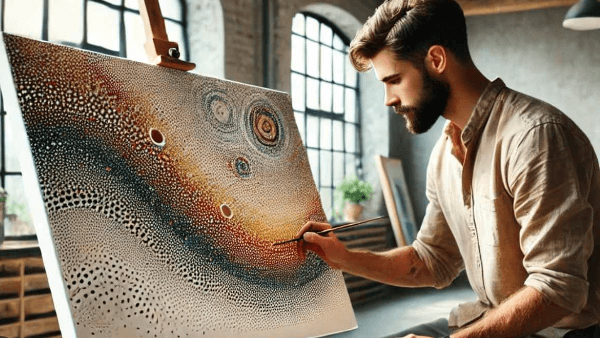Discover the Intricacies of Pointillism: A Revolutionary Art Technique
What is Pointillism?
Pointillism is a distinct painting technique that emerged in the late 19th century as part of the post-impressionist movement. Unlike traditional brushstrokes, artists using Pointillism applied tiny dots of color to create a cohesive image. These small, precise dots of pure color blend visually in the viewer’s eye, forming intricate patterns and detailed compositions. The result is a luminous, vibrant artwork that seems to shimmer with light and energy.
Origins of Pointillism
Pointillism was first developed by the French painter Georges Seurat and his contemporary Paul Signac. Seurat’s masterpiece A Sunday Afternoon on the Island of La Grande Jatte is widely considered one of the finest examples of this method. The approach was heavily influenced by color theory, particularly the way different hues can blend to create various tones when viewed from a distance. This technique marked a significant departure from traditional painting methods, as it relied on scientific precision rather than the subjective application of color.
Key Concepts of Pointillism
- Color Theory: Pointillists believed that placing contrasting colors side by side would result in a more vibrant effect than mixing them on a palette.
- Optical Blending: Rather than blending colors on the canvas, Pointillists allowed the viewer’s eye to mix the colors.
- Scientific Approach: The method was rooted in a systematic, almost mathematical, approach to applying color, which contrasts with the more emotive and spontaneous strokes of Impressionism.
The Technique of Pointillism
Pointillism is a painstaking process that requires patience and precision. Artists begin by plotting out their composition and then apply small dots of color across the canvas. These dots are usually pure colors from the color wheel—red, blue, yellow, and more—without any blending on the artist’s part. As the viewer steps back, these dots blend together to form a coherent image.
Steps to Create Pointillism Art
- Sketching the Composition: The artist first outlines the subject lightly on the canvas.
- Applying the Dots: Using a fine brush, the artist applies small, uniform dots of paint. Each dot must be placed carefully to maintain the overall integrity of the image.
- Building Layers: Multiple layers of dots are added over time, creating depth and complexity.
- Viewing from a Distance: The final step is to step back and observe the way the colors merge in the viewer’s eyes.
Notable Pointillism Artists
While Seurat and Signac are often hailed as the pioneers of Pointillism, many other artists adopted and adapted the technique. Some of the most famous Pointillist painters include:
- Henri-Edmond Cross: Known for his landscapes and seascapes, Cross infused a vibrant energy into his works through the use of this technique.
- Camille Pissarro: One of the founding members of the Impressionist movement, Pissarro later adopted Pointillism, experimenting with its ability to convey light and atmosphere.
- Théo van Rysselberghe: A Belgian painter, van Rysselberghe was heavily influenced by Seurat and used Pointillism to create evocative portraits and landscapes.
Pointillism’s Influence on Modern Art
Pointillism’s precise and methodical approach to color had a lasting impact on modern art. The movement paved the way for new forms of abstraction and minimalism. While the technique itself may not be widely practiced today, its influence is evident in various modern and contemporary art styles, particularly in its emphasis on color theory and the visual blending of hues.
Famous Pointillism Paintings
Several masterpieces were created using this technique. Some notable works include:
- A Sunday Afternoon on the Island of La Grande Jatte by Georges Seurat
- The Pine Tree at Saint-Tropez by Paul Signac
- The Yellow Sail by Henri-Edmond Cross
Where to Buy Pointillism Paintings
For art collectors or enthusiasts, Pointillism paintings offer a stunning addition to any collection. The attention to detail and vibrant colors make these artworks stand out in any setting. If you’re looking to bring this unique style into your home, you can buy pointillism paintings here: https://www.1st-art-gallery.com/pointillism.html.
The Legacy of Pointillism
Although the movement was relatively short-lived compared to others, its impact on art history is profound. Pointillism challenged traditional painting methods and introduced new ways to think about color and composition. Its influence can still be seen in various forms of modern art, and the scientific approach to color blending continues to be a subject of study for artists and scholars alike.
Why Collect Pointillism Art?
- Timeless Technique: The method itself is a testament to artistic patience and precision.
- Unique Visual Appeal: Pointillist paintings create a luminous, almost otherworldly effect.
- Historical Significance: Owning a Pointillist piece connects you to an important chapter in art history.
Conclusion
Pointillism remains one of the most fascinating techniques in the history of art. Its methodical approach, rooted in color theory and precision, continues to inspire artists and captivate audiences. Whether you’re an artist looking to explore this technique or an art lover seeking to expand your collection, Pointillism offers a vibrant and unique perspective on the world of painting.






